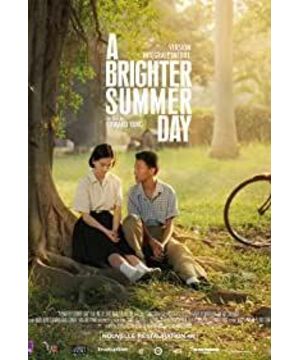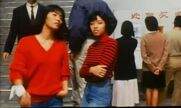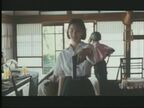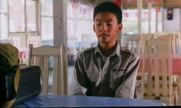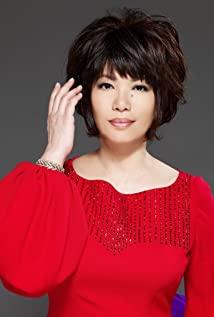Midterm assignments for a class. ddl was written sloppily before, but it is indeed two classics that are very worthy of comparative analysis. I will revise when I have time during the summer vacation
1 Introduction
Jiang Wen's directorial debut "Sunny Day" (hereinafter referred to as "Sunshine") is often compared with Taiwanese director Yang Dechang's "Guling Street Teenage Murder" (hereinafter referred to as "Guling Street"), and the reason is quite intuitive. The latter's English name A Brighter Summer Day is quite close to "Sunshine". Of course, comparing two films side by side always requires a reason. There are many similarities between the two films, but the author believes that only one obvious question is needed to justify the legitimacy of this comparison and guide further analysis: why do the two dramas reminisce about their youth in the 1960s in the 1990s past?
From the main line of the story, both films are quite simple: "Sunshine" tells the story of Ma Xiaojun, a left-behind child in Beijing during the "Cultural Revolution", who fell in love with Milan, but has no regrets, while "Guling Street" tells the story of The story is about a young boy Si'er (Si'er) who kills his girlfriend by accident while intercepting his good brother who is stealing his girlfriend. One of these two stories comes from Jiang Wen's own life experience, and the other comes from real events that happened in Taiwan in the 1960s. Both directors use a whole movie to tell, especially "Kuling Street" which is 4 long. How did they try to explain their stories? What are you trying to convey to people nearly thirty years later? These two questions constitute the two main directions of questioning why recall.
The ignorance and love, the simple story line and countless awards instead set off the two films that deserve attention at a level other than the story. Therefore, this article attempts to interpret their artistic expression from the unique film language of the two, and analyzes the similarities and differences of the two directors' questions through corresponding comparisons.
2. Light and Shadow: An Analysis of the Language of Film
2.1 The language of light and shadow: surplus and lack
The most intuitive difference between the two films is the construction of light and shadow, which is expressed in color on the one hand, and contrast between light and dark on the other hand.
"Sunshine" is bright, and the "sunshine" in the title literally runs through every corner of the film: First of all, except that the swimming pool scene must be based on blue, the colors of the main body of the film are yellow and green. Zhongzheng corresponds to the bright summer sun and the green trees beside the road in the field; the embellishment color related to Ma Xiaojun is mainly red, such as the red decoration of military uniforms and the pavilion of the compound, while the scenes related to Milan are dominated by colder blue. The masters, such as the outfits of Milan and Liu Yiku in the pavilion, and several shots of Milan's residences that deliberately suppressed the warm tone, gave clear hints about the characters of the two and the final outcome. Second, the film uses a lot of warm lighting to enhance the brightness of the picture on the basis of natural light. For example, Figure 1 shows the scene where Ma Xiaojun was hiding under the bed when he was at home in Milan. Even at the bottom of the bed, the orange right side was used. Light (actor light), front light (background light) and white slanted top light (modifying light), the overall picture remains bright with warm tones. The decorative lights of beads, pupils and nose wings mainly serve to portray the three-dimensional sense and tension of the characters, not to mention the outdoor strong light scenes. This kind of design effectively expresses the brilliance of "sunshine" and the beauty of summer. Extremely hot, with the soft light and glare of the lens, it also implies that the memories are both real and illusory. Third, in addition to the natural shadows necessary for scene arrangement, the film deliberately weakens shadows or softens the dividing line between light and dark in many places, especially in the places where group portraits are created, so as to weaken the three-dimensionality of characters in specific scenes. Enhance the dreaminess of memories. Finally, even in the night scenes, the film deliberately eschews the direct confrontation of black and white, leaving the black and white shots to the reality of the ending.
In contrast, "Guling Street" runs through dim light and shadow throughout the play. Rather, in my opinion, the film is deliberately based on the disappearance of shadows or light, with light as the narrative character. First of all, this movie has a lot more night scenes than "Sunshine", which is naturally related to the setting of night school and the gang activities among teenagers. In these scenes, although the scenes involving adults are not as heavy as "Sunshine", dark blue is used, but at least the normal dark blue dark light is used to outline the background, as if it is the same as in real life, but in many scenes about children, it is These lights are intentionally weakened or even canceled. The most typical example is the power outage scene during the killing of Shandong. At most, the fighting scene is only represented by some silhouettes, but the light of the flashlight in Figure 2 has become a guide for the audience to understand the event, one by one. Examine the blood-stained face. Second, even in the daytime scenes, scenes such as Xiao Si’s home, the doctor’s office, and Xiao Si’s father’s interrogation room are relatively dim. These places connected to their destiny suggest repression and potential oppression through the lack of light, and from the specific The scene expands to the entire film.
Therefore, the difference in the use of light and shadow between the two films can be summed up succinctly as the difference between the abundance and lack of light. For "Sunshine", the weakening of the contrast of light and shadow and the surplus of sunlight suggest that the audience is a memory, and it is a memory that seems to be true and illusory. The toughest contrast of light and shadow - black and white represents reality; for "Guling Street", It is said that the "absence" of light rather than the shadow itself is the focus of the use of light and shadow, and light even serves as a narrative function in certain scenes.
2.2 Lens language: passion and silence
The lens language of these two films is quite distinctive in three aspects: movement, setting, and composition.
In terms of lens movement, "Sunshine" can undoubtedly attract the attention of all audiences: quite a lot of hand-held lens movements make the picture appear jitter visible to the naked eye. In the 1990s when camera stabilization technology was relatively mature, there is no doubt that this was The director's intentional setting. The jittery field of vision reinforces the dreaminess and unreality of the memories, while the long shots that accompany the characters reinforce the narrative’s first-person perspective, softening environmental factors in most scenes. "Guling Street" shows the opposite characteristics: the movement of the camera is rarely seen in the whole film, even if there is some movement, it is a smooth movement using rails, etc. The picture avoids any artificial movement as much as possible, so that the whole narrative is calm and peaceful repressed. The director also likes to use long shots, but unlike "Sunshine", the long shots of "Guling Street" often track the loss of characters, making the dialogue take place outside the screen. This deliberately created sense of movement and the "missing" of characters Also plays an important role in the play.
In terms of scenes, "Sunshine" uses all three kinds of scenes. It is worth noting that close-ups are often used to follow Ma Xiaojun's vision, and the details of most other people's actions are not emphasized with close-ups, which reminds the audience again. The whole play is a first-person narrative of Ma Xiaojun; in contrast, the depiction of Ma Xiaojun's personal life rarely uses the panorama, and the scenes of the mass activities of the adults are hardly used in the scenes below the medium scene. A deliberate distinction is made between the two. "Guling Street" once again shows its "missing" characteristics. Except for a few dialogues between Xiao Si, Xiao Ma and Xiao Ming, there are almost no close-ups in the whole film, which makes the audience maintain the relationship with the story as a bystander. A certain distance; at the same time, the entire film rarely uses a large panorama, and prefers to use editing to explain the environment, conveying a suppressed and impenetrable environmental emotion.
In terms of composition, "Guling Street" has a characteristic that breaks the convention: the director introduced a small panorama in the composition of many characters suitable for close-up dialogues, as shown in Figure 3 and Figure 4, they constitute a long without editing. The camera, and more importantly, the director intentionally made a small door frame as the foreground in the picture, creating the feeling that the dialogue takes place in a small space, and strengthening a repressed emotion.
2.3 Auditory language: noise and silence
The use of sound in the two films is worlds apart. "Sunshine" makes extensive use of music, with the main chorus and orchestral accompaniment throughout the film, and the characters' dialogues are less silent. It is worth noting that the main melody sung by adults is always major or traditional pentatonic music, while the accompaniment of children singing or dancing is accompanied by minor works, such as "Night on the Outskirts of Moscow", this difference will be The worlds of adults and children are separated, and children imitate adults to learn some songs and dances, but the use of minor keys implies that they do not know what they need. In contrast, "Guling Street" once again shows its "missing" characteristics: silence rather than sound plays a major role in the film. The entire film did not use any soundtrack or narration, only the sound of the scene appeared, so that in many places the scene was only accompanied by the noise of the movie screening. This kind of silence also especially appears in the dialogues of characters. The rhythm of the dialogues of adults is obviously slower than that of children. There are pauses beyond our daily habits, and some polite responses are directly replaced by silence. This setting further exaggerates the repression and suspicion among the Taiwanese people under the White Terror, especially among adults.
2.4 Narrative structure: space and time
The analysis of light and shadow, camera lens and auditory language reveals the repression created by the simulacrum of Sunshine and the "absence" of Guling Street, and the analysis of the narrative structure will specifically enlighten us on the purpose of the two films . The author believes that both films convey information through contrast very well. They both narrate in two dimensions of time (a period of youth) and space (different life fields of adults and children), but "Sunshine" is more It focuses on the comparison in the spatial dimension, while "Guling Street" focuses more on the comparison in the time dimension.
For "Sunshine", the most stark contrast is the lively jubilation of adults and the ignorance and recklessness of children during the "Cultural Revolution". Almost all the adults in the play are making revolutions. Except for Ma Xiaojun’s parents, all the scenes about adults are group portraits with the main theme chorus. This approach cancels the character characteristics of the adults making the revolution, and uses them as the background of the times. In this way, it shows the lack of adults in the growth of children in adolescence, and compares the naughty, ignorant and reckless children with the neat, disciplined and serious lives of adults, emphasizing that children are different from the mainstream during this period. awareness, and this difference brings confusion. The life of adults is an "other" to them, and although they also imitate this "other", they cannot really integrate into it.
And "Guling Street" highlights the transformation of the same character before and after an event, and this emphasis is accomplished by replaying the scene. For example, Figure 5 and Figure 6 are the two repetitions of a crucial sentence in the film: "You have to believe that your future can be determined by your own efforts". Bicycle on the way home from school. The completely different reactions of the father in these two similar scenes reflect the transformation of the father under the weight of reality. After the inexplicable interrogation and loss of work, the father no longer insists on his ideals and beliefs as before, but Focusing on making a living will also become sullen for the schoolwork of the fourth grader. The same technique is also used in the scenes of Shandong in the billiard hall, the slicker in the classroom, the little four at the gate of the studio, and the little Ming at the gate of the school. personal. Each person's transformation stems from certain events, and it is these events and their contexts that bind their destiny together.
3. The question of subjectivity
According to the above analysis, it is not difficult to draw the following conclusions: "Sunshine" tries to explore "who am I", while "Guling Street" tries to explore "how can I be like this". Or, going back to the question raised at the beginning of this article, "Sunshine" establishes its own subjectivity in the 1990s by recalling the 1960s, while "Guling Street" analyzes the source of the subjectivity in the 1990s through the 1960s . To be more precise, both issues are the focus of the two directors, but each has its own emphasis. So how will they respond?
Obviously, in "Sunshine", the main body recognized by the social mainstream is not an individual, but a group subject performed by adults. They occupy the main position of social life, sing and build the main theme of society, but for Ma Xiaojun said that they were nothing but the Other, and an Other who was not very tolerant of himself. In the movie, we can see that Ma Xiaojun was also subtly influenced by this background. He secretly wore his father's medal to imitate the soldiers, and sang songs he learned from the streets, but he was not one of them, even rejected by them. Even his own mother hates iron, but she just beats and scolds him without educating him how to grow up. In such an environment, Ma Xiaojun can only construct his own subjectivity. He has no guidance, or the only guidance is that he can't be like adults now. Therefore, youth's agitation like the sun, violent emotional catharsis, and brilliance in front of the sweetheart, extreme and rebellious behaviors in mainstream discourse all appear to be rationalized in the hands of the director. However, the film does not promise that they are the subjectivity that this generation of youth should build. On the contrary, the emotions and agitation themselves become scenes that are both real and imaginary: in the end, the story has to be objective at the birthday party, and memories are inevitably intertwined with imagination, so that the narrator (the self in the 90s) I have to sigh: "How strong is the desire to tell the truth, how great is the various disturbances. I sadly found that it is impossible to restore the truth at all." This doubt quickly spread to the whole memory, and he began to doubt Milan identities, doubting all memories about them. While the correct recollection appears to be coming back, the shock seems to have made the recollection seem less believable. Through this scene, Jiang Wen shows a complex emotion for the construction of the subjectivity of teenagers in the 1960s. On the one hand, he constructed a personalized narrative of youth through this film. The first-person perspective, the confrontation with the other, and the enthusiastic camera language all affirmed the path of seeking self-subjectivity in youth, but on the other hand , he also expressed the inevitable dilemma that this kind of construction will eventually usher in—the confusion of dreams, just as the hazy light and shadow and the vagueness of the real and the illusion suggest that this kind of pure individual subjectivity 's pessimism is ultimately calibrated by the ending of being isolated by the playmates.
As revealed in the analysis of film language, "Guling Street" focuses on "absence". The author believes that the absence of dimensions such as light, sound, and characters constantly reminds the audience to pay attention to the layer hidden behind the appearance, which is also the key to understanding the film. In "Guling Street", there are three teenagers who especially show the characteristics of individual subjectivity: a freshman who is a good student, Hani, who can read the martial arts temperament from "War and Peace", and a juvenile spirit before the trial. 's father. It is a pity that their endings were quite tragic: Hani was pushed under the wheel by Shandong, Xiaosi's father was completely devastated after the interrogation, and Xiaosi himself sent away the youth of the two with a few knives. Xiao Ming's evaluation of Hani also applies to the other two people: "Everyone is afraid of him, to death. In fact, no one knows that he is the most honest person. I will tell him that the world will not change because of you." This sentence is diametrically opposed to Xiao Si's father's advice to Xiao Si: "You have to believe that your future can be determined by your own efforts." This film pushes the subjective passions of these remaining individuals to destruction one by one, which is the source of the tragedy and irony of the whole play. With them as the main line, the side of the "missing" - now what we better call occult - unfolds. The audience is always required to appreciate it as a bystander, they and the actors are always separated by a foreground, all the plots take place on the constructed stage, and each actor is just a performance in conjunction with the tragedy. This is the life of the people in the play: they live in the fabric of society, they have to play a role, and there is no way for them to exercise any subjective passion here, their fate is already predestined - a heroic arrogance Hani finally had to surrender to death, and Xiao Si's father, who had a sense of superiority to Taiwan and a righteous body, had to become humble, and Xiao Si, who was a good boy, had to stand in line between the two gangs in the night school, and the moment he entered the school gate. determined an inescapable fate. The same is true for mothers, ponies, slickers, etc. They have to be alienated by society [1] , and what this film denounces is the irresistibility of the social structure and the annihilation of their passion for people. Throughout the film Their resistance is marked by death, and these deaths are either ignored by society (for example, Hani’s death is regarded as a simple car accident), or they are counteracted by society (for example, Xiao Si was forced to stand in line until he was finally sentenced). Ironically, the hidden social structure in the movie hides human subjectivity in reality.
So far, we have answered how the two directors interpret their stories and what thoughts they try to convey to the audience. Before closing, there is one more detail that must be noted in the original question: why should we reflect on the 1960s in the 1990s? That is, why these two points in time? The author believes that, apart from a realistic factor—the teenagers in the 1960s were the main middle-aged force in the film and television industry in the 1990s, the more core reason should be found in history. China in the 1960s was in the period of the Cultural Revolution, and many group portraits in the play "Sunshine" portrayed the characteristics of this period, especially the scene of the North Korean delegation's performance in China. At this time, people have a strong collective consciousness, adults are busy making revolutions, and although the children in the military compound will not be directly affected by the revolution, they are really unable to independently understand the complex world outside, and it is even difficult to understand what they experience in adolescence. To the ignorant emotion. The 1990s was an era when the Soviet Union disintegrated and the Cold War pattern was broken. China became the largest socialist country, and reform and opening up brought a violent impact from the Western trend. In the midst of drastic changes, how did the generation who grew up in the 1960s survive? There is no way to return to the era of high collective consciousness before the 1960s, nor can it be urgent to regain one's own consciousness of subjectivity from memory under the condition of being in a hurry all day long. In this context, "Sunshine" can evoke the contemporaries. It resonated with countless people and achieved box office success on the premise of maintaining a high degree of artistry. In contrast, in the 1960s, the other side of the strait had fled the mainland for more than ten years. The authorities, knowing that there was no hope of returning to the mainland, were constantly exaggerating the sentiment of "counterattacking the mainland". Tanks and people could be seen everywhere on the streets. The tense and oppressive atmosphere of the dialogue between them all set off the white terror at that time. When the youth of this era grew into the 1990s and saw that the development on the other side of the strait was getting better and better, the political situation on the island was different, but the development was not as good as on the other side, and even the problem of social disintegration became more and more serious, they thought And you should consider yourself obliged to reflect on how it all happened, which is why Yang Dechang tells the story of "Guling Street".
View more about A Brighter Summer Day reviews


